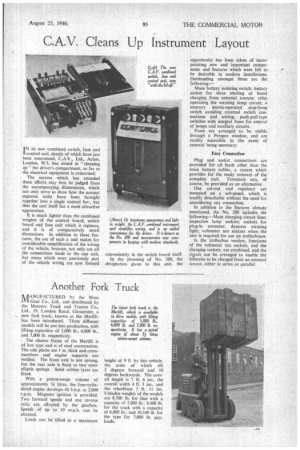C.A.V. Cleans Up Instrument Layout
Page 47

If you've noticed an error in this article please click here to report it so we can fix it.
TN its new combined switch, fuse and 1 control unit, details of which have just been announced, C.A.V., Ltd., Acton. London, W.5, has aimed at "cleaning up" the driver's compartment, so far as the electrical equipment is concerned.
The success which has attended these efforts may best be judged from the accompanying illustrations, which not only serve to show how the normal separate units have been brought together into a single control her, but that the unit itself has a most attractive appearance.
It is much lighter than the combined weights of the control board, switch board and fuse unit which it replaces, and it is of comparatively small dimensions. In addition to these features, the use of such a unit makes for considerable simplification of the wiring of the vehicle, because, not only are all the connections made to the one unit, but many which were previously part of the vehicle wiring are now formed conveniently in the switch board itself. In the planning of No. 200, the designation given to this unit, the
opportunity has been taken of incorporating new and important components and features which were felt to be desirable in modern installations. Outstanding amongst these are. the following:—
Main battery isolating switch; battery socket for slave starting or boost charging from external sources; relay operating the warning lamp circuit; a mercury inertia-operated stop-lamp switch avoiding external switch connections and setting; push-pull-type switches with integral fuses for control of lamps and auxiliary circuits.
Fuses are arranged to be visible through a Perspex window, and are readily accessible in the event of renewal being necessary.
Easy Connection Plug and socket connections are provided for all leads other than the main battery cables, a system which provides for the ready removal of the complete unit Terminals can, of course, be provided as an alternative.
One cut-out and regulator are mounted on a sub-panel, which is readily detachable without the need for unsoldering any connection.
In addition to the features already mentioned, the No. 200 includes the following:—Main charging circuit fuse; inspection lamp• sockets; sockets for plug-in ammeter; dynamo whming light; voltmeter test sockets when the unit is required for use on trolleybuses.
In the trolleybus version, functions of the voltmeter test sockets, and the charging sockets, are combined, and the ciicuit can be arranged to enable the batteries to be charged from an external source, either in series or parallel.




































































